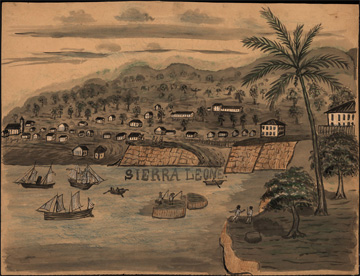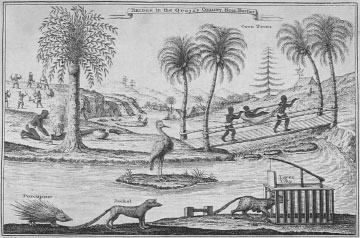Sierra Leone


Sierra Leone was one of the first locations in West Africa to attract European interest. As early as the mid-fifteenth century, Portuguese sailors saw the Sierra Leone River estuary as a good location to procure fresh water and food. In the decades that followed, many different European nations engaged in commerce with the peoples who lived along the coast before a notable trade in human captives began.
Sierra Leone’s history eventually became enmeshed in that of the movements for the abolition and suppression of the transatlantic slave trade. After the American Revolution, Great Britain evacuated several thousand Black Loyalists to different places in its empire, like London and Nova Scotia in Canada. This group was composed of former slaves who supported the British war effort or who sought refuge behind British lines. The Black Loyalists who arrived in London added to existing numbers of Africans and their descendants (as well as some Asians and West Indians) who had escaped from slavery or had been manumitted in Britain. Many of these people suffered under terrible poverty and lack of employment and depended on public or private assistance to survive.
In 1786, the British “Committee for the Relief of the Black Poor” began its mission by soliciting charitable donations and by establishing a colony in Sierra Leone. The “Province of Freedom” in Sierra Leone would offer a permanent home for impoverished blacks under the protection of the British crown and the Royal Navy. In 1787, the first group of about four hundred men and women arrived from Great Britain. The settlement and its residents suffered a number of internal and external setbacks and nearly failed.
When conditions in Nova Scotia proved to be unfavorable for the Black Loyalists there, Sierra Leone was offered as a site for relocation. About 1200 black Nova Scotians chose to move on British ships in 1792 to Sierra Leone where they established the Freetown Colony. Although the crown promised the settlers self-government and racial equality, it failed to fully deliver. The settlements of the Committee for the Relief of the Black Poor and the Nova Scotians established the roots of Freetown, which would become the capital of Sierra Leone.
A final influx of new residents arrived in 1800 after the Maroon Wars in Jamaica. In its effort to suppress a long conflict in Jamaica, Great Britain exiled more than five hundred formerly enslaved soldiers and their families to Freetown.
Great Britain outlawed the transatlantic slave trade in 1807 and began to use the Royal Navy’s West Africa Squadron to enforce its ban. The squadron was based in Freetown, which in 1808 had been made a crown colony. As the squadron patrolled and intercepted slave trading vessels all along the African coast, it landed these “re-captives” in Freetown. Many of these re-captives chose to remain in Sierra Leone, helping to build the colony’s population. The diverse sources of Freetown’s settlers—drawn from North America, the Caribbean, and many African nations—composed Sierra Leone’s own ethnic group, the Krio, with their own unique language and cultural forms.
History & Memory
Related Pages:
-
 Model based on a Liverpool slave ship
Model based on a Liverpool slave ship
-
 Museum of London Docklands
Museum of London Docklands
-
 Olaudah Equiano
Olaudah Equiano
-
 Antera Duke
Antera Duke
-
 West Africa
West Africa

